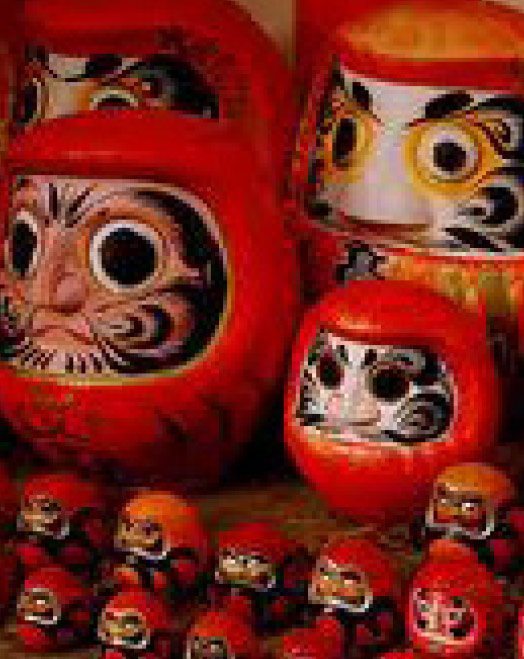Shinto, Buddhism and the Japanese belief system
Religion in Japan is a wonderful mish-mash of ideas from Shintoism and Buddhism. Unlike in the West, religion in Japan is rarely preached, nor is it a doctrine. Instead it is a moral code, a way of living, almost indistinguishable from Japanese social and cultural values.
Japanese religion is also a private, family affair. It is separate from the state; there are no religious prayers or symbols in a school graduation ceremony, for example. Religion is rarely discussed in every day life and the majority of Japanese do not worship regularly or claim to be religious.
However, most people turn to religious rituals in birth, marriage and death and take part in spiritual matsuri (or festivals) throughout the year.
Religion and the Emperor
Until World War Two, Japanese religion focused around the figure of the Emperor as a living God. Subjects saw themselves as part of a huge family of which all Japanese people were members.
The crushing war defeat however, shattered many people's beliefs, as the frail voice of the Emperor was broadcast to the nation renouncing his deity. The period since has seen a secularisation of Japanese society almost as dramatic as the economic miracle which saw Japan's post-war economy go into overdrive.
However, much of the ritual has survived the collapse of religious belief. Today, religion defines Japanese identity more than spirituality, and at helps strengthen family and community ties.
Shintoism versus Buddhism

Shintoism is Japan's indigenous spirituality. It is believed that every living thing in nature (e.g. trees, rocks, flowers, animals - even sounds) contains kami, or gods.
Consequently Shinto principles can be seen throughout Japanese culture, where nature and the turning of the seasons are cherished. This is reflected in arts such as ikebana (flower arranging) and bonsai, Japanese garden design and the annual celebration of sakura - or cherry blossom.
Shinto only got its name when Buddhism came to Japan by way of China, Tibet, Vietnam, and ultimately Korea. Buddhism arrived in the sixth century, establishing itself in Nara. Over time Buddhism divided into several sects, the most popular being Zen Buddhism.
In essence, Shintoism is the spirituality of this world and this life, whereas Buddhism is concerned with the soul and the afterlife. This explains why for the Japanese the two religions exist so successfully together, without contradiction. To celebrate a birth or marriage, or to pray for a good harvest, the Japanese turn to Shintoism. Funerals, on the other hand, are usually Buddhist ceremonies.
Shrines versus temples
As a general rule of thumb, shrines are Shinto and temples are Buddhist. Shrines can be identified by the huge entrance gate or torii, often painted vermillion red. However you'll often find both shrines and temple buildings in the same complex so it is sometimes difficult to identify and separate the two.
To appreciate a shrine, do as the Japanese do. Just inside the red torii gate you'll find a water fountain or trough. Here you must use a bamboo ladle to wash your hands and mouth to purify your spirit before entering.
Next, look for a long thick rope hanging from a bell in front of an altar. Here you may pray: first ring the bell, throw a coin before the altar as on offering (five yen coins are considered lucky), clap three times to summon the kami, then clasp your hands together to pray.
At a temple, you'll need to take your shoes off before entering the main building and kneeling on the tatami-mat floor before an altar or icon to pray.
Lucky charms
Luck, fate and superstition are important to the Japanese. Many people buy small charms at temples or shrines, which are then attached to handbags, key chains, mobile phones or hung in cars to bring good luck. Different charms grant different luck, such as exam success or fertility.
Prayers are often written on votive tablets: wooden boards called ema that are hung in their hundreds around temple grounds. At famous temples such as Kyoto's Kiyomizu-dera, you'll see votive tablets written in a variety of languages.
A final way to learn your destiny is to take a fortune slip. Sometimes available in English, a fortune slip rates your future in different areas: success, money, love, marriage, travel and more. If your fortune is poor, tie your slip to a tree branch in the temple grounds; leaving the slip at the temple should improve your luck.
Religious ceremonies
The most important times of year in the Japanese calendar are New Year, celebrated from the 1st to the 3rd of January, and O-Bon, usually held around the 16th of August. At New Year the Japanese make trips to ancestral graves to pray for late relatives. The first shrine visit of the New Year is also important to secure luck for the year ahead.
At O-Bon it is believed that the spirits of the ancestors come down to earth to visit the living. Unlike Halloween, these spooky spirits are welcomed and the Japanese make visits to family graves.
Births are celebrated by family visits to shrines. The passing of childhood is commemorated at three key ages: three, five and seven, and small children are dressed in expensive kimono and taken to certain shrines such as Tokyo's Meiji Shrine. Coming of age is officially celebrated at 20. In early January, mass coming of age ceremonies (like graduations) are held in town halls followed by shrine visits by young people proudly dressed in bright kimono.
In Japan today, marriage ceremonies are a great clash of East meets West. A Japanese wedding may have several parts, including a Shinto ceremony in traditional dress at a shrine as well as a Western-style wedding reception in a hotel or restaurant. In the second part it is now popular for a bride to wear a wedding gown for a howaito wedingu (white wedding).
Funerals are overseen by Buddhist priests. 99% of Japanese are cremated and their ashes buried under a gravestone. To better understand Japanese funerals, InsideJapan Tours highly recommend the Oscar-winning film Okuribito, or Departures, about a concert cellist who goes back to his roots in Yamagata and retrains as an undertaker.
Japanese matsuri are festivals connected to shrines. In a tradition stretching back centuries matsuri parades and rituals relate to the cultivation of rice and the spiritual wellbeing of the local community.
Other religions
According to Article 20 of the Japanese constitution, Japan grants full religious freedom, allowing minority religions such as Christianity, Islam, Hinduism and Sikhism to be practiced. These religions account for roughly 5-10% of Japan's population. However, the spiritual vacuum left by the Emperor's renunciation was also rapidly filled by a plethora of new religions (shin shukyo) which sprung up across Japan.
Mainly concentrated in urban areas, these religions offered this-worldly benefits such as good health, wealth, and good fortune. Many had charismatic, Christ-like leaders who inspired a fanatical devotion in their followers. It is here that the roots of such famous "cults" as the "Aum cult of the divine truth", who perpetrated the Tokyo subway gas attack of 1995, can be found.
However, the vast majority of new religions are focused on peace and the attainment of happiness, although many Japanese who have no involvement appear suspicious of such organisations. Tax-dodging or money-laundering are, according to some, par for the course.
Some of the new religions, such as PL Kyoden (Public Liberty Kyoden) and Soka Gakkai, have, however, become very much a part of the establishment in Japan, and it seems their role in politics and business is not to be underestimated.
Where to visit?
For those who have an interest in Buddhism or Shinto, Japan is full of fascinating places to visit. Nara, in the Kansai region near Osaka, is thought to be the original home of Buddhism in Japan and features an extensive museum of Buddhist art and artifacts, as well as the huge statue of Buddha that is Nara's central visitor attraction.
Kyoto is full of beautiful shrines and temples and can provide a unique look back through history to a time when religious belief was a more significant part of everyday life, as well as being simply stunning to behold. In fact, everywhere you go in Japan, you will see the face of the country's religious heritage.
Featured trips
-
Small Group Tour
Classic Japan (IJT Classic)
- Tokyo
- Hakone
- Osaka
- Kyoto
- Takayama
- Japan Alps
- Tokyo
Classic Japan combines the famous cultural sights of Japan with the staggering natural beauty of its mountainous region. You'll visit the “golden route”: Tokyo, Kyoto and Hakone, but also spend four days in the beautiful Japan Alps – including Kamikochi National Park, a place we think is a contender for one of the most stunning on Earth.
13 nights: AU$10595 Read more >
-
Self-Guided Adventure
Traditional Japan (Classic)
- Tokyo
- Kanazawa
- Shirakawago
- Takayama
- Matsumoto
- Tsumago
- Kyoto
- Tokyo
A classic 14-night adventure introducing the traditional side of Japan, from Japanese-style inns to time-honoured cuisine and ancient temples.
14 nights: from AU$7938 pp (twin share) Read more >
-
Self-Guided Adventure
Pilgrim's Paths (Classic)
- Tokyo
- Kyoto
- Mount Koya
- Kawayu Onsen
- Yunomine Onsen
- Nachi
- Ise
- Tokyo
Join the ranks of the junreisha, or pilgrims, as you explore Ise, Mount Koya and the ancient paths of the Kumano Kodo on this classic trip.
14 nights: from AU$7791 pp (twin share) Read more >
 UK
UK
 USA
USA





 Inside Japan UK office
Inside Japan UK office Inside Japan US office
Inside Japan US office Inside Japan Australia office
Inside Japan Australia office Inside Japan - Japan office
Inside Japan - Japan office



























